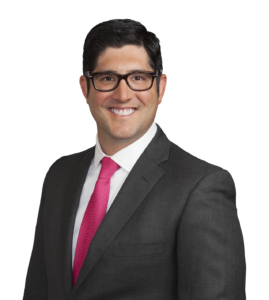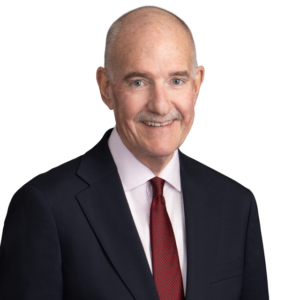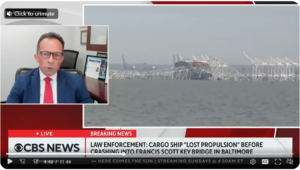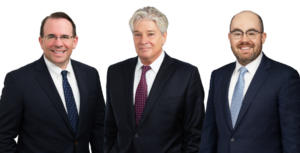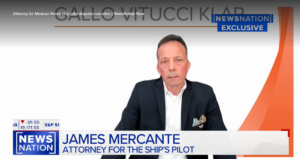We are proud to share that James E. Mercante has been recognized by his peers in the 2026 edition of The Best Lawyers in America for his outstanding work in Admiralty and Maritime Law.
For more than 40 years, Best Lawyers has been regarded as the most credible measure of legal integrity and professional distinction. Inclusion is based on a rigorous peer-review process, reflecting the respect and recognition of fellow attorneys in the field.
As a Best Lawyers honoree, Mr. Mercante joins an esteemed group of practitioners who exemplify the highest standards of the profession. His recognition further underscores our firm’s commitment to providing exceptional counsel and advocacy in the maritime arena.
We extend our congratulations to James on this well-deserved honor.
Plaintiff, who was 56 years-of-age at the time of the accident, alleged to have sustained a significant low back injury when his vehicle came into contact with our client’s tractor-trailer. As a result, plaintiff underwent multiple low back surgeries, leaving him unable to work and in need of a walking device.
With coverage well into the millions of dollars, this claim posed a significant risk for our clients. In an effort to mitigate that risk, the parties mediated. However, mediation proved unsuccessful, necessitating our motion for summary judgment. Through the motion, we sought dismissal under New York’s Insurance Law § 5102(d). Using carefully secured deposition testimony, medical records and expert affidavits, we are argued plaintiff’s debilitating injuries were not caused by the accident and therefore, were not “serious injuries” within the meaning of the statute.
In opposition, plaintiff submitted multiple affidavits. In our reply, we highlighted numerous flaws in the affidavits, arguing the evidence upon which plaintiff opposed the motion was legally inadequate to overcome our prima facie entitlement to dismissal. The Court obviously found our position availing and dismissed plaintiff’s claim.
Although largely academic, as part of this motion, we also successfully obtained dismissal on behalf of truck’s owner pursuant to the Grave’s Amendment. This decision then led to the Court changing the venue of the case from Kings County to Sullivan County, which was another application made within the motion.
Congratulations to Martin Rowe on securing a unanimous defense verdict in a personal injury case tried before the Hon. Francis Ricigliano in Nassau County Supreme Court.
A jury was selected on July 21st, and the case was tried before the Hon. Francis Ricigliano, commencing on July 28th and concluding with a defense verdict on July 30th.
The plaintiff was a member of a Masons Lodge that was undergoing some renovations. Our client owned a landscaping dump truck. At the request of his son-in-law, also a member of the Masons Lodge, our client lent the truck to the Lodge for debris removal. He drove the truck to the Lodge, parked it, and returned home. The Masons had previously used the truck under the same arrangement.
The plaintiff, an electrician by trade, was one of the volunteers at the Lodge that morning. He testified that he was attempting to lower the rear tailgate of the dump truck, which weighs 400–500 pounds, when it detached completely, causing it to fall on him and crush his left hand. The plaintiff alleged that we provided the truck in an unsafe condition and that our client had a duty to remain behind to ensure that those using the truck knew how to operate it.
The plaintiff testified that he had only removed 2 of the four pins holding the gate and “does not remember” if the safety chains were present. Two fellow Masons were called as witnesses, but both gave differing accounts of how the accident happened, also not remembering if the safety chains were present.
The defendant testified that he delivered the truck as he had done before, without incident. All the pins and chains were in place when he left the truck. He stated that he lived one mile from the hall and would have returned to instruct anyone who asked.
The defense called Kevin Tully, B.E. in Mechanical Engineering. Mr. Tully testified that he had inspected the truck and used his photos to explain to the jury the proper functioning of the gate and its components. He testified that the door could only have fallen off if all four pins and both safety chains were removed. If the plaintiff had only removed the top pins, as he claimed, the door would not have fallen off. Mr. Tully also testified that the truck could not have been driven to the hall with the pins and chains already removed, as the gate would have fallen off during transport.
The jury initially asked for the photographs. Shortly thereafter, they delivered a unanimous verdict in favor of the defense.
A jury was selected in this matter on July 1st-3rd and tried before the Hon. Peter Sweeney commencing on July 9th and concluding with a damage’s verdict on July 24th.
The plaintiff, Marcus Santiago, a window installer, was injured in the course of his employment when he slipped on algae covered exterior stairs on the property owned by our client 90 Eighth Ave Housing Corp. Plaintiff’s employer, Windows We Are successfully moved to dismiss our clients third party action as the contract lacked indemnity and/or additional insured provisions. The case was originally pled as a structural defect case (the steps were in poor condition) but for some reason plaintiff testified at his deposition that he slipped on algae and the pleadings were never amended.
Liability was tried on July 9th -11th. Prior to summations, the LL 240(1) and 241(6) causes of actions were dismissed. The LL 200 charge was incorporated into the general negligence charge. The judge also granted our application to dismiss the actual notice claim and reserved decision on the constructive notice claim letting it go to the jury. The jury returned a 100% adverse verdict finding constructive notice. I renewed my motion for a directed verdict arguing a lack of evidence. The Judge continued to reserve, directing me to file a post-trial motion on the issue.
A damages trial proceeded on July 14th and was finished on July 18th. Summations and charge proceeded on July 23rd. The jury deliberated for 2 days.
The plaintiff sustained a herniation at L5-S1. Lattuga performed a discectomy and fusion surgery and following a failed surgery Lattuga recommended and adjacent segment surgery at L4-5. Dr. Merola provided a second opinion that adjacent segment surgery was necessary. Plaintiff did not have the second surgery but testified at trial he is going to have it.
Plaintiff also treated for torn lateral ligaments in his ankle. Touliopoulos performed a reconstructive surgery. Following little improvement, a second surgery was suggested. Again, he didn’t have the surgery but testified he is going to have it.
Plaintiff raised his demand to 6.1 million following a $300,000 offer. A high low of $750,000-$2,500,000 was also rejected. Counsel was not interested in negotiating following the liability verdict.
The plaintiff’s economist projected future medical based on an Life Care Plan (LCP) prepared by Carfi as well as lost wages. $2,942,890.00 for future medications and $3,331,107.00 future lost earnings were “black boarded” by the plaintiff’s attorney.
Our experts Dr. Kim (spinal surgeon), Dr. Weinfeld (orthopedic), Dr. Canter (LCP) and Mark Ramnauth (vocational rehabilitation), were very credible witnesses (later confirmed by the jury). During closing, I suggested various amounts totaling close to $600,000.
Plaintiff’s attorney asked for $2,000,000 past pain and suffering and $3,000,000 future pain and suffering. She also requested the amounts “black boarded” by the plaintiff’s attorney for a total of $11,273,997.00
The jury returned a damages verdict awarding nothing for past and future damages; $200,000 for past lost earnings and $125,000 for future lost earnings; $150,000 for past medications and $15,000 for future medications. Total damages are $490,000.00. There was also a $750,000 settlement offer on the table, in addition to a high-low agreement that was discussed but not accepted.
Joseph Rava, Co-Chair of our New York Labor law practice, in Garnett Waite v. County of Westchester (S. Ct Westchester County) defeated plaintiff’s summary judgment motion on his Labor Law Sections 240(1) and 241(6) claims and won summary judgment on plaintiff’s negligence, Labor Law Sections 200, 241(6), and 240 claims in a case involving a worker who claims he fell into a trench while guiding a septic tank into the trench. The plaintiff alleges he was injured, while working at ground level and assisting with the placement of a septic tank into an excavation at the project. While he was holding one of six taglines attached to the concrete tank that was being lowered into an excavated pit, plaintiff slipped on soil and slid into the excavation. On behalf of our client we argued, with the support of a client affidavit and an expert affidavit, that plaintiff was exposed to usual and ordinary dangers of a construction site, was not subjected to a gravity related risk covered by Labor Law 240(1), could not establish violations of any Industrial Code rules as a predicate necessary to trigger Labor Law Section 241(6) liability and could not establish that the defendants were negligent or violated Labor Law Section 200. The court agreed with our arguments and supporting case law and found that the plaintiff was subject to the usual and ordinary dangers of a construction site and Labor Law Section 240 did not apply. The court, in finding that Labor Law Section 241(6) and Industrial Code Rule 23-1.7 (d)(1) “Slipping hazards” were not violated, agreed with our argument that plaintiff did not fall into a “hazardous opening” as contemplated by the regulation and that Industrial Code Rule 23-1.7(b) does not apply to these facts. On the Labor Law Section 200 and common law negligence claims, the court found that the defendant established through the client’s affidavit that the defendant did not observe any unsafe conditions on the site before the date of the occurrence and did not direct or control the work of the plaintiff.
This dramatic new video animates and narrates the events leading up to the container ship DALI’s crash, which caused the collapse of the Francis Scott Key Bridge in Maryland; one of the largest casualties in maritime history. GVK partner James Mercante is featured as a maritime expert.
Kim Townsend & Andrew Lauri of GVK’s Trial Team obtained a trial victory in a contentious unified Queens County motor vehicle case involving lumbar herniations, cervical herniations, cervical fusion surgery, shoulder labral tears and shoulder surgery.
Plaintiff was previously awarded conditional summary judgment against our client on liability, which was affirmed by the Appellate Division, Second Department, which also held that plaintiff’s comparative fault was to be determined by the jury. At trial, the Court awarded plaintiff a directed verdict on liability and dismissed our affirmative defense of comparative fault right before summations despite the Appellate Court’s decision, and despite dashcam video evidence showing plaintiff travelling at an excessive speed, failing to keep a proper look out, and unsafely changing lanes at the time of the accident.
Kim Townsend argued that, based on the reliable medical evidence, plaintiff’s fusion surgery was entirely unnecessary, and plaintiff’s pre-surgical treatment was steered entirely by his first attorney, before his trial attorneys were retained. The trial narrative echoed complaints of endemic fraud currently permeating our courts.
On summation, plaintiff’s attorneys asked for $6,000,000. While the jury was deliberating, the parties entered in a high/low agreement of $500,000/$1,500,000. After 3 days of deliberation, the jury returned a verdict of $250,000.
Briggs Johnson of GVK’s Appellate Practice Group also spent two full days in the Second Department arguing several thorny and hotly contested appellate issues that arose in the middle of trial, including trial court’s decision to strike our affirmative defense of plaintiff’s comparative fault.
Gallo Vitucci Klar LLP is pleased to announce the promotion of four attorneys, Nadine Ibrahim, Melissa Russo-Jordan, David Landfair and Jaqueline Roman, to Of Counsel in recognition of their continued dedication, leadership, and outstanding contributions to the firm and its clients.
Please join us in congratulating:
Nadine Ibrahim focuses her practice on commercial transportation litigation and automobile defense. Before joining Gallo Vitucci Klar LLP, she served at the New York City Office of Corporation Counsel, where she represented the City of New York in federal civil litigation, gaining valuable experience in high-stakes government defense.
Melissa Russo-Jordan brings over a decade of experience in premises liability, motor vehicle, and labor law insurance defense. Prior to joining the firm, she handled a wide range of federal matters with a focus on maritime and admiralty law, further strengthening her broad litigation background.
David Lanfair has extensive experience representing both plaintiffs and defendants in personal injury protection litigation, as well as individuals and small businesses in civil and transactional matters. His work has included business sales, loan agreements, and complex franchise-related issues. David has also successfully briefed and argued appeals before the Appellate Division, First and Fourth Departments, and the Appellate Term, Second Department.
Jaqueline Roman has represented both plaintiffs and defendants in insurance coverage and personal injury litigation. Before joining Gallo Vitucci Klar LLP, she worked as in-house counsel for an automobile insurance company, managing UM/SUM claims and defending bodily injury cases. She also has considerable experience in No-Fault litigation, having advocated on behalf of both sides.
Each of these attorneys has demonstrated a high level of legal acumen and a commitment to excellence. Their promotion reflects the firm’s ongoing investment in the professional growth of its attorneys and the value they bring to our clients across all practice areas. We are proud to celebrate this important milestone in their careers and look forward to their continued success!
GVK admiralty partner James Mercante, attorney for the New York pilot aboard the training ship that collided with the Brooklyn Bridge Saturday evening, appears on today’s NewsNation interview to discuss the facts of the tragic incident.
In this widely distributed, London-based podcast recently launched by Lloyd’s List journalists, GVK Maritime Partner James Mercante joins a Lockton marine insurance broker and a Maryland state legislator to discuss the DALI ship collision that destroyed the Francis Scott Key Bridge. The episode explores the legal aftermath one year later, including heated litigation, multi-billion-dollar claims, key defenses, critical NTSB findings, and predictions!

